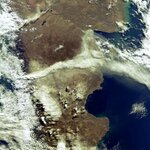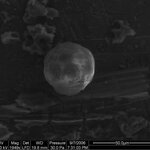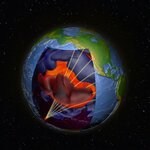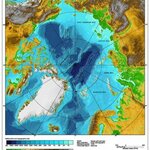Geology

Until 1992, when California’s magnitude-7.3 Landers earthquake set off small jolts as far away as Yellowstone National Park, scientists did not believe large earthquakes sparked smaller tremors at distant locations. Now, a definitive study shows large earthquakes routinely trigger smaller jolts worldwide, including on the opposite side of the planet and in areas not prone to quakes.
“Previously it was thought seismically active regions or geothermal areas were most vulnerable to large earthquake triggers,” says Kris Pankow, a seismologist at the University of Utah Seismograph Stations and a…

Last summer, researchers writing in the international journal Tectonics concluded that geological faults in the Sichuan Basin, China “are sufficiently long to sustain a strong ground-shaking earthquake, making them potentially serious sources of regional seismic hazard."
An international team of scientists including Dr. Alexander Densmore (Institute of Hazard and Risk Research, Durham University), Dr. Mike Ellis (Head of Science for Climate Change at the British Geological Survey) and colleagues from research institutes in Chengdu, carefully mapped and analysed a series of geologically young…

A new study of possible links between climate and geophysics on Earth and similar planets finds that prolonged heating of the atmosphere can shut down plate tectonics and cause a planet's crust to become locked in place.
"The heat required goes far beyond anything we expect from human-induced climate change, but things like volcanic activity and changes in the sun's luminosity could lead to this level of heating," said lead author Adrian Lenardic, associate professor of Earth science at Rice University. "Our goal was to establish an upper limit of naturally generated climate variation beyond…

Chile’s Chaiten Volcano is shown spewing ash and smoke (centre left of image) into the air for hundreds of km over Argentina’s Patagonia Plateau in this Envisat image acquired on 5 May 2008.
The 1000 m-high volcano had been dormant for thousands of years before erupting on 2 May, causing the evacuation of thousands. Chaiten Volcano is located in southern Chile 10 km northeast of the town of Chaiten on the Gulf of Corcovado.
Envisat’s Medium Resolution Imaging Spectrometer (MERIS) instrument processed this image at a resolution of 1200 m.
Chile's Chaiten Volcano is shown spewing ash and…

A comparison of recorded Antarctic temperatures and snowfall accumulation to predictions by major computer models of global climate change offer both good and bad news.
The good news is that the numerical models’ predictions covering the last 50 years broadly follow the actual observed temperatures and snowfall for the southernmost continent, although the observations are very variable.
The bad news is that a similar comparison that includes the last 100 years is a poor match. Projections of temperatures and snowfall ranged from 2.5 to five times what they actually were during that period…

Beads known to geologists as carbon cenospheres were formed from liquefied carbon deep in the earth when an asteroid struck some 65 million years ago, according to a new theory.
The carbon cenospheres were deposited next to a thin layer of the element iridium -- an element more likely to be found in Solar System asteroids than in the Earth's crust. The iridium-laden dust is believed to be the shattered remains of the 200-km-wide asteroid's impact. Like the iridium layer, the carbon cenospheres are apparently common. They've been found in Canada, Spain, Denmark and New Zealand.
But the…

A new model of inner Earth constructed by Arizona State University researchers pulls past information and hypotheses into a coherent story to clarify mantle motion.
“The past maybe two or three years there have been a lot of papers in Science and Nature about the deep mantle from seismologists and mineral physicists and it’s getting really confusing because there are contradictions amongst the different papers,” says Ed Garnero, seismologist and an associate professor in Arizona State University’s School of Earth and Space Exploration.
“But we’ve discovered that there is a single framework…

Scientists probing volcanic rocks from deep under the frozen surface of the Arctic Ocean have discovered a special geochemical signature until now found only in the southern hemisphere. The rocks were dredged from the remote Gakkel Ridge, which lies under 3,000 to 5,000 meters of water; it is Earth’s most northerly undersea spreading ridge.
The Gakkel extends some 1,800 kilometers beneath the Arctic ice between Greenland and Siberia. Heavy ice cover prevented scientists from getting at it until the 2001 Arctic Mid-Ocean Ridge Expedition, in which U.S and German ice breakers cooperated.
This…

The earthquake on April 18, 2008, about 120 miles east of St. Louis, registered 5.2 on the Richter scale and hit at 4:40 a.m. with a strong aftershock occurring at approximately 10:15 a.m. that morning, followed by lesser ones in subsequent days. The initial earthquake was felt in parts of 16 states.
To the surprise of many, originated in the Wabash Valley Fault, not the better-known and more-dreaded New Madrid Fault in Missouri’s boot heel.
The concern of Douglas Wiens, Ph.D., and Michael Wysession, Ph.D., seismologists at Washington University in St. Louis, is that the New Madrid Fault…

Gondwana was a ‘supercontinent' comprised of Antarctica, South America, Africa, Madagascar, Australia-New Guinea, and New Zealand, as well as Arabia and the Indian subcontinent of the Northern Hemisphere.
It existed between 500 and 180 million years ago but geologists have debated for decades over how it eventually broke up. The two primary camps support a theory claiming the continent separated into many small plates and a second theory believes it broke into a few large pieces.
In a new paper published in ‘Geophysical Journal International’, Dr. Graeme Eagles at the University of London…